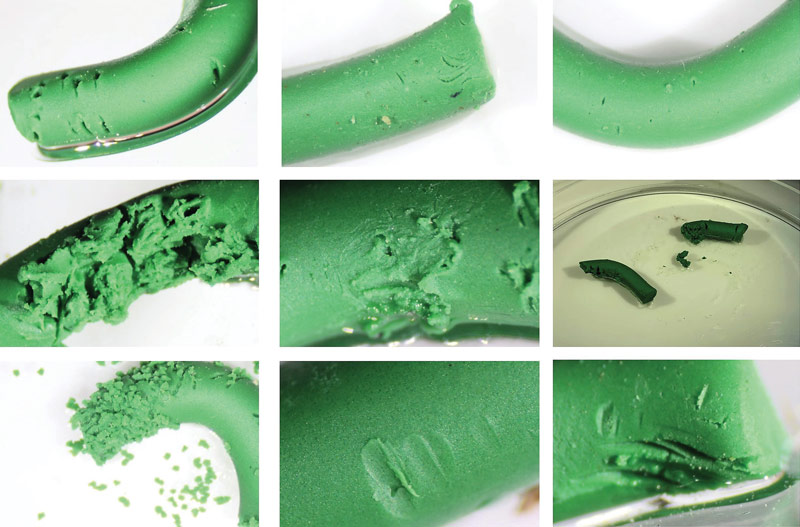
University of Georgia researchers used modeling clay to create faux larvae, which were set upon by turfgrass predators. They left behind telltale marks for the team to study. Photos courtesy of Fawad Khan
Turfgrass managers might eventually have some new nonchemical weapons to wield against common pests like black cutworms and fall armyworms thanks to a bit of research at the University of Georgia that took a novel tack with an old medium.
Fawad Khan, a Fulbright scholar and entomology doctoral candidate at UGA, and his team used modeling clay to fashion simulated larvae, which were promptly set upon by various natural predators. The predators left behind telltale impressions in the soft clay. The Georgia team hopes analysis of the marks left behind will lead to a better understanding of predation in the turfgrass environment.
“Our goal was to understand and improve the biological control provided by beneficial insects,” says Khan, who published results in the November 2020 edition of the journal Entomologia Experimentalis et Applicata. “Ultimately, using this tool, we anticipate we can enhance awareness about the role beneficial insects play on pest management on golf courses and sod farms.”
Khan and his team, which included Shimat Joseph, Ph.D., assistant professor of entomology at UGA, were aware of the use of clay modeling in other settings previously, notably in tropical forests and agricultural landscapes, to estimate predation levels. However, Khan says the technique hadn’t before been attempted in a turfgrass system. If the collected arthropods — common Georgia turfgrass predators, including spiders, ants, carabid beetles, earwigs and more — hadn’t engaged, the study would have been over before it really began.
Fortunately for the researchers, the predators cooperated, leaving behind nine distinct impressions in the faux caterpillars.
Describing it as a kind of a “brain hack” of the predators, Khan says the marks give an indication of how the beneficial bugs interact with the pests, which are most vulnerable in their larval stage. It can be difficult to study such activity, however, because it leaves scant evidence.
Enter the clay models.
For the study, the team created two sizes of clay “larvae” and collected natural predators from the turf at UGA’s Griffin campus. The predators spent 48 hours in a petri dish with the models — enough time for them to mark the fake prey. The researchers also studied clay models in a fire ant mound in the field. The clay is relatively inexpensive and easy to work with, Khan says.

The arthropods left nine distinct impression types, which Khan viewed under a microscope. He labeled the impressions: paired marks, scratches, pricks, deep distortion, disturbed surface, detached segments, granulated surface, dents or elongated scratches. Interestingly, he said, earwigs were the only predators to leave marks characterized as granulated surface impressions.
Editor’s note: Incorporating flowering plants on golf courses is a well-known strategy for aiding pollinators, but the practice offers another perk: attracting predatory and parasitic insects for natural pest control. Learn more in Wildflowers bring in beneficial insects.
Khan came to UGA to study environmentally friendly options for pest management, particularly the use of beneficial insects. He says a practical application from the study — say, an integrated pest management program that relies on biological control as a first line of defense and only triggers chemical management when pest levels reach a certain benchmark — could be well into the future. But the early research does provide a potential baseline now for measuring predator activity in turfgrass. Now the research, which is part of Khan’s dissertation work, will compare that activity between different systems.
“The idea was conceived when we tried to compare and contrast the biological control activity, mostly predation, in commercial — such as sod farm or golf — and residential settings,” Khan says. “To interpret the data from these settings, we needed more information on how and what types of impressions common turfgrass predators would leave on clay models.”
The clay modeling can help researchers know which predators are present before eventually trying to manipulate them to serve as a more efficient control method.
“We are currently studying ways to refine this tool and trying (to see) if this tool can be used in various turfgrass systems to assess predation,” Khan says. “If this works, we could expand it as a diagnostic tool for predator activity and improve the integrated pest management strategies in golf and on sod farms.
“Gradually, we hope the practitioners will see the benefits of biological control (as evident on clay models) and incorporate conservation strategies, such as reducing unnecessary sprays, using selective, reduced-risk insecticides, and ultimately improving IPM.”
Andrew Hartsock is GCM’s managing editor.